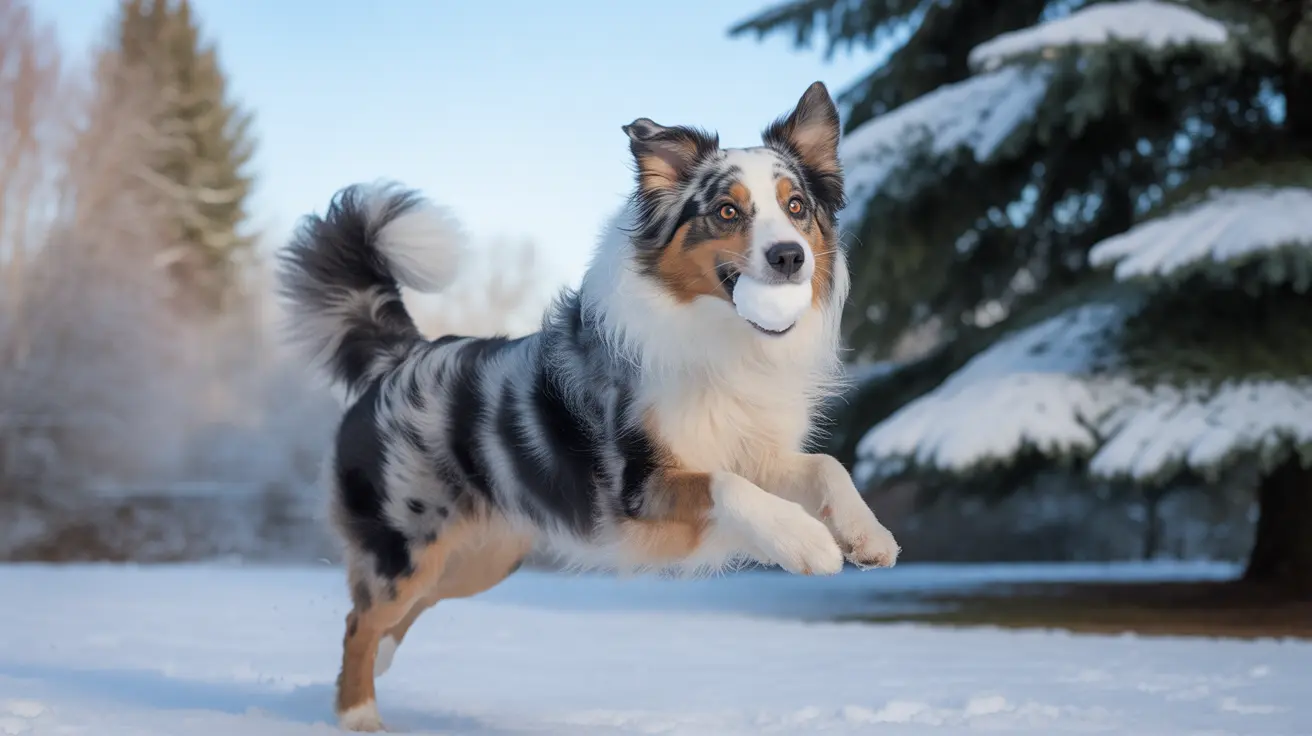Winter Hazards for Dogs: Essential Safety Guide for Snow and Ice Dangers
Winter brings magical moments for dog owners and their furry companions, from watching your pup's first encounter with falling snowflakes to witnessing their pure joy as they bound through fresh powder. However, beneath this winter wonderland lurk serious dangers that many pet owners don't recognize until it's too late. Understanding these winter hazards for dogs is crucial for keeping your beloved companion safe during the coldest months of the year.
From the toxic chemicals used to melt ice on sidewalks to the hidden dangers of seemingly innocent snow consumption, winter presents unique challenges that require proactive preparation and constant vigilance. This comprehensive guide will equip you with the knowledge needed to protect your dog from winter's most dangerous threats while still allowing them to enjoy the season's pleasures safely.
Understanding Snow Consumption Risks
Most dogs instinctively want to eat snow when they encounter it, and this behavior is generally normal and harmless in small quantities. However, excessive snow consumption can lead to serious health complications that every dog owner should understand.
When Snow Becomes Dangerous
While small amounts of clean, fresh snow are typically safe for dogs to consume, problems arise when dogs eat large quantities or contaminated snow. Consuming excessive amounts of snow can significantly lower your dog's body temperature and cause gastrointestinal distress. The cold temperature of the snow can shock your dog's digestive system, leading to uncomfortable symptoms and potentially more serious complications.
The real danger comes from "dirty" snow found near streets, sidewalks, and driveways. This contaminated snow often contains harmful chemicals, road salt, antifreeze residue, and hidden debris like sticks or rocks that can cause internal injuries or poisoning.
Snow Gastritis: A Hidden Winter Threat
Snow gastritis is a condition that develops when dogs consume large quantities of snow, causing irritation and inflammation of the stomach lining. This condition is particularly common during the first major snowfalls of the season when excited dogs may overindulge in their snowy treats.
Causes and Development
Snow gastritis typically occurs when the cold temperature of consumed snow disrupts normal digestive processes. The sudden temperature change can cause stomach muscles to contract abnormally, leading to inflammation and irritation of the stomach walls. Additionally, if the snow contains any contaminants or foreign particles, these substances can further aggravate the digestive system.
Recognizing the Symptoms
Dog owners should watch for several key symptoms that may indicate snow gastritis:
- Persistent vomiting, sometimes containing blood
- Loss of appetite and reluctance to eat
- Lethargy and decreased energy levels
- Abdominal discomfort or pain
- Blood in stool or dark, tarry stools
- Excessive drooling
- Restlessness or inability to find a comfortable position
Treatment Approaches
Early veterinary intervention is crucial for successful treatment of snow gastritis. Treatment typically involves supportive care including anti-nausea medications, stomach protectants, and in severe cases, intravenous fluid therapy to prevent dehydration. Most dogs recover fully with prompt treatment, but delays can lead to more serious complications requiring intensive care.
The Toxic Effects of De-icing Chemicals
Road salt and other de-icing chemicals present one of the most serious winter hazards for dogs. These substances are specifically designed to melt ice and snow, but they can cause severe health problems when ingested by pets.
Common De-icing Chemicals and Their Dangers
Traditional rock salt (sodium chloride) is the most common de-icer, but it can cause stomach upset, dehydration, and electrolyte imbalances when consumed. More dangerous chemicals include calcium chloride, magnesium chloride, and potassium chloride, all of which can cause severe gastrointestinal irritation and potentially life-threatening salt poisoning.
Some municipalities and property owners use even more toxic substances like calcium magnesium acetate or sodium ferrocyanide, which can cause more severe poisoning symptoms and require immediate emergency veterinary care.
Salt Poisoning: Recognition and Response
Salt poisoning occurs when dogs consume significant amounts of de-icing chemicals, either by eating contaminated snow or licking their paws after walking on treated surfaces. Symptoms of salt poisoning include:
- Excessive thirst and urination
- Vomiting and diarrhea
- Lethargy and weakness
- Loss of coordination
- Tremors or seizures in severe cases
- Difficulty breathing
- Coma in extreme cases
If you suspect salt poisoning, contact your veterinarian or emergency animal hospital immediately. Time is critical, and early treatment significantly improves the chances of full recovery.
Preventive Measures for Winter Walks
Prevention is always better than treatment when it comes to winter hazards for dogs. Implementing proper preventive measures can protect your pet from most cold-weather dangers while still allowing them to enjoy outdoor activities.
Protective Gear and Clothing
Dogs without thick, weather-resistant coats benefit significantly from proper winter clothing. Waterproof or water-resistant jackets help maintain body temperature and prevent snow from accumulating on your dog's fur. For extremely cold conditions, layering a fleece or sweater under a waterproof outer coat provides additional warmth.
Dog booties offer excellent protection from frostbite, salt, and sharp ice. Choose boots with good traction and waterproof materials, and acclimate your dog to wearing them before venturing into snowy conditions. If booties aren't practical for your dog, paw wax creates a protective barrier that prevents ice and snow from clumping between toes and pads.
Safe Walking Practices
Limit outdoor playtime to approximately 30 minutes at a time, especially for small, short-haired, elderly, or young dogs who are more vulnerable to cold-related health issues. Gradually acclimate your dog to colder weather rather than suddenly exposing them to extreme conditions.
Shovel pathways through deep snow to make movement easier for your dog, and avoid areas where you can see blue or green substances that might indicate antifreeze contamination. Keep your dog leashed on snow and ice to prevent them from getting lost or falling through unsafe surfaces.
Recognizing Early Warning Signs
Early recognition of cold-weather health problems can mean the difference between a minor issue and a life-threatening emergency. Dog owners should be vigilant for signs that their pet is experiencing difficulties in winter conditions.
Physical Warning Signs
Watch for shivering, which is often the first sign that your dog is becoming too cold. Other physical indicators include lifting paws off the ground repeatedly, reluctance to walk or continue outdoor activities, and attempts to return indoors before completing normal activities like bathroom breaks.
Check your dog's extremities regularly for signs of frostbite, including discoloration, swelling, blistering, or areas that feel unusually cold or brittle. Frostbite most commonly affects paws, ears, and tail tips after prolonged exposure to cold conditions.
Behavioral Changes
Cold stress often manifests through behavioral changes before physical symptoms become apparent. Dogs may become lethargic, withdraw from normal activities, or show decreased interest in food or play. If your normally energetic dog seems unusually tired or disinterested after winter outdoor time, this could indicate developing hypothermia or other cold-related health issues.
Safer Alternatives and Pet-Friendly Options
Many pet-safe alternatives to traditional de-icing chemicals are now available for conscientious pet owners and communities. These products effectively melt ice while posing significantly reduced risks to animals.
Pet-Safe De-icers
Look for products specifically labeled as pet-safe or pet-friendly. These alternatives often use ingredients like potassium acetate or magnesium chloride in lower concentrations that are less likely to cause serious health problems if small amounts are ingested. However, even pet-safe products should be used according to manufacturer instructions and kept away from curious pets.
Some communities are adopting sand-based traction aids instead of chemical de-icers, which provide slip resistance without the toxic risks associated with salt-based products. Advocate for pet-safe alternatives in your neighborhood and consider using them on your own property.
Comprehensive Winter Safety Protocol
Developing a comprehensive winter safety routine helps ensure your dog stays healthy and comfortable throughout the cold season. This protocol should address both prevention and post-outdoor care.
Pre-Walk Preparation
Before heading outdoors, apply paw wax or petroleum jelly to your dog's paw pads to create a protective barrier against salt and ice. Ensure your dog is wearing appropriate clothing for the weather conditions, and bring a towel for drying them off after your walk.
Check weather conditions and adjust your plans accordingly. If temperatures are too extreme for human comfort, they're likely too extreme for your dog as well, regardless of breed or coat thickness.
Post-Walk Care
After every winter walk, wash your dog's paws and stomach thoroughly with warm water to remove ice, snow, salt, and chemical residues. Dry your dog completely, paying special attention to areas between toes where ice balls can form. Check paws for signs of irritation, cracking, or injury, and apply moisturizing balm as needed.
Provide fresh, clean water to help your dog stay hydrated, as winter air can be very drying. Ensure your dog has access to a warm, comfortable resting place away from drafts where they can recover from cold exposure.
Additional Winter Health Considerations
Beyond the immediate dangers of snow consumption and chemical exposure, winter presents several other health challenges that responsible dog owners should address proactively.
Hypothermia Prevention
Hypothermia occurs when a dog's body temperature drops below normal levels, typically due to prolonged exposure to cold conditions. Small dogs, puppies, senior dogs, and those with underlying health conditions are particularly vulnerable. Signs include severe shivering, cold extremities, lethargy, and in severe cases, loss of consciousness.
Prevention involves limiting outdoor exposure time, providing appropriate clothing, and ensuring your dog has adequate body fat and muscle mass to maintain body temperature. Dogs with short fur or certain health conditions may need extra care and shorter outdoor sessions even in moderately cold weather.
Maintaining Exercise Routines
Don't neglect your dog's exercise needs during winter months. Continue regular walks and play sessions, adjusting duration and intensity based on weather conditions. On days when outdoor exercise isn't safe, provide indoor alternatives like puzzle feeders, indoor games, or supervised treadmill exercise for larger dogs.
Mental stimulation becomes especially important when physical exercise is limited. Interactive toys, training sessions, and food puzzles can help prevent boredom and maintain your dog's mental health during long winter months.
Frequently Asked Questions
How much snow is too much for my dog to eat?
While small amounts of clean snow are generally safe, you should prevent your dog from consuming large quantities. If your dog eats more than a few mouthfuls or shows any signs of gastrointestinal distress after snow consumption, monitor them closely and consult your veterinarian if symptoms develop.
What should I do if my dog ate snow that might contain salt or chemicals?
If you suspect your dog has consumed contaminated snow, offer fresh water immediately and contact your veterinarian. Watch for symptoms like vomiting, diarrhea, excessive thirst, lethargy, or coordination problems. Don't wait for symptoms to develop if you know they've consumed a significant amount of treated snow.
How can I tell if my dog has frostbite?
Frostbite typically affects extremities like paws, ear tips, and tail ends. Look for skin discoloration (pale, gray, or blue), swelling, blisters, or areas that feel unusually cold or brittle. If you suspect frostbite, seek veterinary care immediately and avoid attempting to warm the affected areas rapidly.
Are some dog breeds more susceptible to winter hazards than others?
Yes, small dogs, puppies, senior dogs, and breeds with short coats or thin fur are more vulnerable to cold-related health issues. Breeds like Chihuahuas, Greyhounds, and other sight hounds need extra protection, while northern breeds like Huskies and Malamutes are naturally better equipped for cold weather.
How long can my dog safely play in the snow?
Limit snow play sessions to about 30 minutes at a time, adjusting based on your dog's size, age, coat thickness, and comfort level. Watch for signs of cold stress like shivering or reluctance to continue playing, and bring your dog inside immediately if they show any discomfort.
What's the best way to remove ice balls from my dog's paws?
Use warm (not hot) water to gently melt ice balls between your dog's toes and paw pads. Never try to chip or break off ice formations, as this can injure the sensitive skin. Regular application of paw wax can help prevent ice ball formation.
Should I change my dog's diet during winter months?
Dogs may need slightly more calories during winter to maintain body temperature, especially if they spend significant time outdoors. Consult your veterinarian about appropriate dietary adjustments based on your dog's activity level, body condition, and individual needs.
Conclusion
Winter hazards for dogs extend far beyond the obvious dangers of extreme cold, encompassing everything from toxic chemical exposure to digestive complications from snow consumption. By understanding these risks and implementing comprehensive preventive measures, you can ensure your dog enjoys winter activities safely while minimizing their exposure to potentially life-threatening dangers.
Remember that vigilance and preparation are your best tools for protecting your pet during winter months. Regular monitoring, appropriate protective gear, proper post-walk care, and immediate veterinary attention when problems arise will help keep your dog healthy and happy throughout even the harshest winter conditions. When in doubt, always err on the side of caution and consult your veterinarian about any winter-related health concerns.






